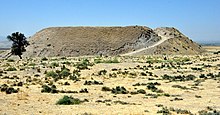Shahrizor
Shahrizor is a plain between Suleimania and Darbandikhan, situated in the southeastern part of Iraqi Kurdistan, Iraq.
- For the Ottoman administrative division see: Shahrizor Eyalet
 |
|
|
Modern history
|
Etymology
The name Shahrazur is likely derived from two Iranian words: shah (king) and razur (forest), hence sharazur meaning kingly forest.[1] Herzfeld based on the fact that in classical sources the name was spelt with an initial /s/ rather /sh/, suggested white forest,[2] which he connected with the Avestan legends. Indeed, to this day the plain of Sharazur has an important status among adherents of native religion of Yarsan as a holy and sacred region where God descends for the Last Judgement.[3] The 12th century geographer Yaqut al-Hamawi, based on folk etymology interpreted origin of name Sharazur, from the name of the son of Zahhak, whom he mentions as founder of the famous city of Sharazor.[4]
History


Extensive archaeological research, especially since 2009, at sites like Bakr Awa, Tell Begum and Gird-î Qalrakh, has shown that the plain has been continuously occupied since prehistoric times.[5]
Sharazor and its king Yazdan Kard are mentioned in the Karnamag, a book of Persian mythology, of Ardashir I[6] and also in the inscription of Narseh alongside Garmian. During the Sassanid era the region of Sharazor was one of the 5 provinces of the satrapy of Medes, an ancient Iranian people.
In the 4th century, some of inhabitants of Sharazor who had converted to Christianity were persecuted by the Sassanids. Among the prominent examples of this persecution is the killing of Bishop Shahdost Shahrazori and 128 of his followers.
Emperor Heraclius spent the month of February in 628 in Shahrazur.
In the year 642 AD, Sharazor witnessed a big battle between Kurds and invading Arab Muslims aiming to conquer the Sassanid empire. After suffering massive casualties, the Arabs assumed control of it in 643 AD.
Sharazur was incorporated into Ardalan Principality from 11th century until the 16th[7] and was its first capital. Its relics are the historic site of Yassin tepe.[8] It formed afterwards part of Baban Principality.
In the Medieval era, the area was incorporated into the territories ruled by many dynasties, including Annazid, Aishanid and also Ayyubid, who were also of Kurdish origins. During the Ayyubid period the region, and the city of Erbil, were granted as a fief to the emir Gökböri by Saladin in 1190.[9]
Yaqoot Hamawi describes the region of Sharazor as areas between Erbil to the west and Hamadan to the east including many cities, towns and villages. He mentions the inhabitants of the region as having been entirely Kurds, who were defended themselves from the Sultan and ruled their area.[10]
See also
- Al-Shahrazuri – 13th-century physician, historian and philosopher
- Kirkuk Governorate
- Sharazoor District
- As Sulaymaniyah Governorate
References
- E.J.W. Gibb memorial series, 1937, E. J. Brill, University of California
- Ernst Herzfeld, Gerold Walser, 1968, The Persian Empire: Studies in geography and ethnography of the ancient Near East, p. 18, ff. Steiner, University of Michigan, 392 pages
- Islamic Desk Reference, by Emeri van Donzel, page: 408, ISBN 90-04-09738-4
- Kitab Mu'jam Al Buldan by Yaqoot Hamawi, Book 3, p: 425–427
- Kopanias, Kostas, John MacGinnis, and Jason Ur (eds.). 2015 "Archaeological Projects in the Kurdistan Region in Iraq." The Directorate of Antiquities of Kurdistan
- The Kārnāmag-ī Ardaxšīr-ī Pābagān, Book of the Deeds of Ardashir son of Babag, Chapter VI
- Kurdistan: Divided Nation of the Middle East - Page 10, by S. S. Gavan. Lawrence & Wishart, 1958
- Encyclopædia Britannica: A New Survey of Universal Knowledge, pg. 521, by Walter Yust, 1951; and The Pageant of Persia: A Record of Travel by Motor in Persia, by James Rives Childs, p. 253, The Bobbs-Merrill Company, 1936.
- Kitab Mu'jam Al Buldan, by Yaqoot Hamawi, vol. 3, pp. 425−427